 W
WThe Advanced Bomb Suit (ABS) is a full body bomb suit designed to protect the Explosive Ordnance Disposal (EOD) soldier from threats associated with improvised explosive devices, including those related to fragmentation, blast overpressure, impact, heat, and flame. Manufactured by Med-Eng, the ABS uses new material technology and design to improve protection, comfort, and ergonomics. The suit is constructed from Kevlar with an outer anti-static cover of 50/50 Nomex/Kevlar and comprises a jacket, crotchless trousers, groin cup, and rigid ballistic panels. To minimize weight and maximize flexibility, protection is provided at various levels, specific to body regions, based on susceptibility to wounds. The suit does not provide gloves to the operator so that maximum ability on the hands is present.
 W
WThe All-Purpose Lightweight Individual Carrying Equipment (ALICE) was adopted as United States Army Standard A on 17 January 1973 to replace the M-1956 Individual Load-Carrying Equipment (ILCE) and M-1967 Modernized Load-Carrying Equipment (MLCE). Although since superseded by MOLLE, ALICE gear is still in some limited use in the U.S. Army in National Guard and training units, as well as by Navy and Air Force ground units.
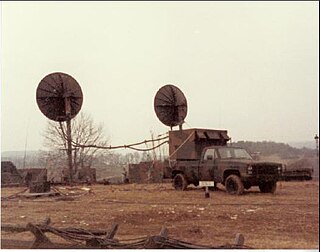 W
WThe AN/TRC-97 Radio Set, or TRC-97, is a radio set that has 12 multiplex channels and 16 telegraph channels connected to an analog radio. The radio set is a mobile terminal that can transmit up to 40 miles (64 km) straight line-of-sight at up to 1 watt, using a traveling wave tube amplifier, or 96 miles (154 km) in tropospheric scatter at up to 1 kilowatt, using a tunable klystron amplifier, at a frequency range of 4.4 to 5 gigahertz and 1.2 to 2.2 gigahertz. The set has been manufactured by RCA, Camden, N.J.
 W
WThe Battle Dress Uniform (BDU) is a camouflaged combat uniform that was used by the United States Armed Forces as their standard combat uniform from the early 1980s to the mid-2000s. Since then, it has been replaced or supplanted in every branch of the U.S. Armed Forces.
 W
WBlue force tracking is a United States military term for a GPS-enabled capability that provides military commanders and forces with location information about friendly military forces. In NATO military symbology, blue typically denotes friendly forces. The capability provides a common picture of the location of friendly forces and therefore is referred to as the blue force tracker. When all capitalized, the term refers to a specific defense contractors' system, but the capability is found in many military and civilian mobile apps.
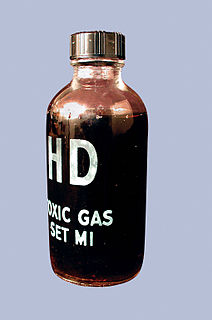 W
WChemical Agent Identification Sets (CAIS), known by several other names, were sets of glass vials or bottles that contained small amounts of chemical agents. They were employed by all branches of the United States Armed Forces from 1928-1969 for the purpose of training in detection, handling and familiarization with chemical warfare. Most CAIS were destroyed in the 1980s but the U.S. Army Chemical Materials Agency still occasionally demilitarizes CAIS that are found buried.
 W
WThe Combat Identification Panel (CIP), also known as a Coalition Identification Panel, is a device mounted on military ground vehicles used by United States Armed Forces' United States Army with United States Marine Corps and its allies to distinguish them from the enemy during battle.
 W
WCIRAS is a modular protective vest designed for US Special Operations Forces by Eagle Industries. The vest is is currently the new FSBE II system, and has replaced the FSBE AAVs. It features PALS webbing, making it MOLLE compatible and allowing the attachment of various pouches or accessories. Two versions of the vest are available known as the "Land" and the "Maritime" versions. The vest consists of front and rear panels with pockets for BALCS or SPEAR cut soft armor panels and standard issue SAPI plates. This gives the wearer up to NIJ Level IV protection on front and back and Level IIIA protection on the sides. On the lower rear side of the front of the vest there are two quick-releasable buckles for attaching groin protection. The wearer's sides are covered by an external cummerbund which is also covered with PALS webbing. The vest body is constructed of 1000 Denier Cordura Nylon and the interior is lined with heavy duty mesh to aid in cooling the wearer.
 W
WThe Common Remotely Operated Weapon Station (CROWS) is a series of remote weapon stations used by the US military on its armored vehicles and ships. It allows weapon operators to engage targets without leaving the protection of their vehicle. The US military has fielded both the M101 CROWS and M153 CROWS II systems.
 W
WDeep Green is a project that ran under the Information Processing Technology Office of the Defense Advanced Research Projects Agency. The purpose of the project was to develop a decision-making support system for United States Army commanders. The systems developed feature advanced predictive capabilities to enable computers to efficiently and accurately predict possible future scenarios, based on an analysis of the current situation, in order to give army commanders a better view of possible outcomes for their decisions
 W
WThe AN/PSN-13 Defense Advanced GPS Receiver is a handheld GPS receiver used by the United States Department of Defense and select foreign military services. It is a military-grade, dual-frequency receiver, and has the security hardware necessary to decode the encrypted P(Y)-code GPS signals.
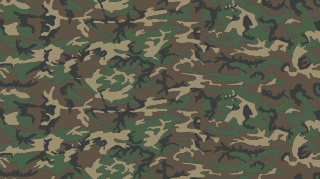 W
WThe ERDL pattern, also known as the Leaf pattern, is a camouflage pattern developed by the United States Army at its Engineer Research & Development Laboratories (ERDL) in 1948. It was not used until the Vietnam War, when it was issued to elite reconnaissance and special operations units beginning early 1967.
 W
WThe FCS Network - Brigade Combat Team (BCT) Network consists of five layers that combine to provide seamless delivery of data to forward-deployed Army units.
 W
WGeneral Electric Company (GE) is an American multinational conglomerate incorporated in New York City and headquartered in Boston. As of 2018, the company operates through the following segments: aviation, healthcare, power, renewable energy, digital industry, additive manufacturing and venture capital and finance.
 W
WGround-Based Midcourse Defense (GMD) is the United States' anti-ballistic missile system for intercepting incoming warheads in space, during the midcourse phase of ballistic trajectory flight. It is a major component of the American missile defense strategy to counter ballistic missiles, including intercontinental ballistic missiles (ICBMs) carrying nuclear, chemical, biological or conventional warheads. The system is deployed in military bases in the states of Alaska and California; in 2018 comprising 44 interceptors and spanning 15 time zones with sensors on land, at sea, and in orbit. In 2019, a missile defense review requested that 20 additional ground-based interceptors be based in Alaska.
 W
WThe Heterogeneous Aerial Reconnaissance Team (HART)—formerly known as the "Heterogeneous Urban RSTA Team (HURT)"—program was an aerial surveillance project funded by the Information Processing Technology Office of the Defense Advanced Research Projects Agency with program managers John Bay and Michael Pagels. The purpose of the program was to develop systems that could provide continuous, real-time, three-dimensional surveillance of large urbanized areas, using unmanned aerial vehicles. The project team was led by Northrop Grumman Corporation, and involved several other academic and corporate researchers.
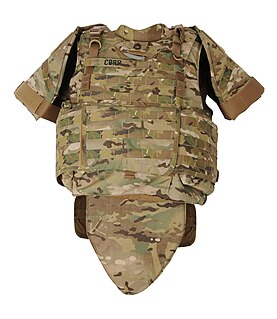 W
WThe Improved Outer Tactical Vest (IOTV) is an enhanced version of, and a replacement for, the older Outer Tactical Vest (OTV) variant of the Interceptor Body Armor, as fielded by the United States Army. The IOTV is compatible with the Deltoid and Auxiliary Protector System (DAPS) components, ESAPI, Enhanced Side Ballistic Inserts (ESBI), as well as the OTV's groin protector. It has a flame-resistant stand-alone shirt known as the Army Combat Shirt designed specifically for use with the IOTV.
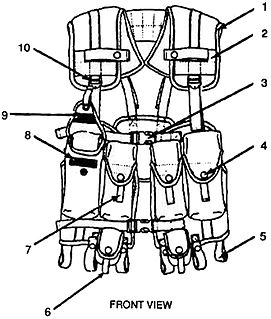 W
WThe IIFS was introduced in 1988, to serve as a fighting and existence carrying system - a possible replacement for the All-Purpose Lightweight Individual Carrying Equipment (ALICE) employed and fielded by United States Armed Forces since 1973.
 W
WThe idea of the gun pod as a concept largely came into its prime during and after World War II. So-called "package gun" installations on US medium and light bombers, such as the B-25 Mitchell and A-26 Invader, were probably the first such attempts by the United States military. One of the primary ideas was to provide additional suppression of ground defenses during attack runs, primarily while conducting maritime interdiction, and the extra armament gave the aircraft additional firepower.
 W
WThe M5 modular crowd control munition (MCCM) is a non-lethal direct fire device used to disperse, incapacitate and deny area access to large groups of people with percussion and flash (flash-bang) along with the impact from 600 high-velocity rubber or plastic balls moving outwards towards the crowd. It can be deployed and set up by troops and detonated via a command wire.
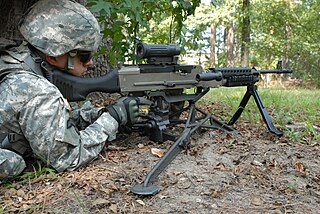 W
WThe M192 Lightweight Ground Mount is a tripod fielded by the United States armed forces. It was designed and developed by Capco, Incorporated under contract through Picatinny Arsenal to replace the M122 tripod. The United States Army named the tripod one of 2005's top ten inventions. It was designed for use with the M249, M240B, and M240L.
 W
WThe McClellan saddle was a riding saddle designed by George B. McClellan, a career Army officer in the U.S. Army, after his tour of Europe as the member of a military commission charged with studying the latest developments in engineer and cavalry forces including field equipment. Based on his observations, McClellan proposed a design that was adopted by the Army in 1859. The McClellan saddle was a success and continued in use in various forms until the US Army's last horse cavalry and horse artillery was dismounted late in World War II. Today, the McClellan saddle is used by ceremonial mounted units in the US Army. The saddle was used by several other nations, including Rhodesia and Mexico, and to a degree by the British in the Boer War. The saddle came in various seat sizes that predominantly ranged from approximately 11 to 12 ½ inches.
 W
WThe RA-1 Military Free-Fall Advanced Ram-Air Parachute System provides a multi-mission, high-altitude parachute delivery system that allows personnel to exit at altitudes between 3,500 feet and 35,000 feet. The parachute, which replaces the current MC-4 parachute, supports a total jumper weight of 450 pounds. It also provides non-MFF personnel with a ram-air parachute that is static-line deployed.
 W
WMobile offshore base (MOB), sometimes called a joint mobile offshore base (JMOB), is a concept for supporting military operations beyond the home shores, where conventional land bases are not available, by deploying on the high seas or in coastal waters, in-theater multipurpose floating base assembled from individual platforms. In essence, a MOB is a multipurpose modular self-propelled floating platform, or several interconnected platforms, that can perform multiple functions of a sea base including strike, deployment and logistics. An ocean-wise semi-submersible wave and wind resistant platform capable of moving at one-half the speed of conventional prepositioning monohull cargo ship has been researched and proposed, but never built.
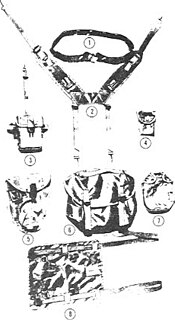 W
WModernized Load-Carrying Equipment, also known as M-1967 Modernized Load-Carrying Equipment or MLCE, was introduced into United States Army service in 1968 during the Vietnam War. The M-1967 MLCE was not specifically designed to replace the canvas and cotton duck M-1956 Load-Carrying Equipment, but instead it was designed for use in tropical environments.
 W
WMOLLE is an acronym for Modular Lightweight Load-carrying Equipment. It is used to define the current generation of load-bearing equipment and backpacks used by a number of NATO armed forces, especially the British Army and the United States Army.
 W
WThe P-38, developed in 1942, is a small can opener that was issued in the canned field rations of the United States Armed Forces from World War II to the 1980s. Originally designed for and distributed in the K-ration, it was later included in the C-ration. As of 2020, it is still in production and sold on a worldwide market.
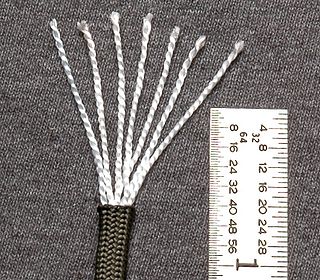 W
WParachute cord is a lightweight nylon kernmantle rope originally used in the suspension lines of parachutes. This cord is now used as a general purpose utility cord. This versatile cord was used by astronauts during the 82nd Space Shuttle mission to repair the Hubble Space Telescope.
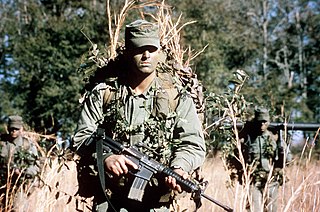 W
WA patrol hat, also known as a field cap, is a soft kepi with a stiff, rounded visor, and flat top, somewhat similar to a baseball cap, worn by the military personnel of some countries in the field when a combat helmet is not required.
 W
WA poncho liner, also known as a woobie, is a piece of field gear originating in the United States military that can be attached to a standard issue poncho to provide additional warmth, as well as being usable as a blanket, sleeping bag or protective cover. It consists of quilted nylon with a polyester filling. It is attached to the poncho by means of integral lengths of material which are looped through the poncho's eyelets.
 W
WThe AN/PSN-11 Precision Lightweight GPS Receiver is a ruggedized, hand-held, single-frequency GPS receiver fielded by the United States Armed Forces. It incorporates the Precise Positioning Service — Security Module (PPS-SM) to access the encrypted P(Y)-code GPS signal.
 W
WHemostatic dressing, such as QuikClot, is a wound dressing that contains an agent that promotes blood clotting.
 W
WRanger Body Armor (RBA) is a U.S. military-issue ballistic vest that was designed for, and used chiefly by, Soldiers of the United States Army 75th Ranger Regiment (“Rangers”) in the 1990s and 2000s. The RBA system has since been replaced by other specialized body armor systems adopted by the United States Special Operations Command (USSOCOM).
 W
WIn the United States military, a rubber duck, or "rubber ducky", or "Blue Gun", or "Red Gun" is a non-functional training weapon that is fully or partially made of rubber or plastic. They are usually M16 rifles, and are commonly used in basic training. Trainees are issued rubber ducks to add realism to training without the dangers and maintenance inherent to real firearms.
 W
WThe Soldier Plate Carrier System (SPCS), known commercially as the KDH Magnum TAC-1, is a bulletproof vest developed for the U.S. Army which provides protection at least as good as the Improved Outer Tactical Vest. The SPCS is a lighter alternative to the IOTV, with increased mobility and comfort.
 W
WA swagger stick is a short stick or riding crop usually carried by a uniformed person as a symbol of authority. A swagger stick is shorter than a staff or cane, and is usually made from rattan. Its use derives from the vine staff carried by Roman centurions as an emblem of office.
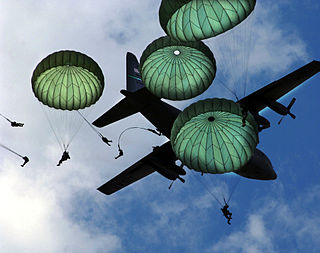 W
WThe T-10 Parachute is a series of static line-deployed parachutes used by the United States armed forces for combat mass-assault airborne operations and training. The T-10 parachute was introduced in the early 1950s. In 1976, the B model introduced the anti-inversion net; in 1986, the C model was introduced, which changed the pocket band free length from 4" to 7½". The T-10D, adopted in 2000, includes the detachable pack tray, which in itself includes the 15' universal static line and 5' extension static line. The T-10D is currently being replaced by the T-11 parachute system. In 2006, all T-10C parachutes were revised by adding one static line stow bar to each side of the pack tray; the material for the T-10C was also changed to the Army's Foliage Green #504.
 W
WThe Non-Maneuverable Canopy (T-11) Personnel Parachute System is the newest personnel parachute system to be adopted by the United States armed forces and the Canadian Army. The T-11 replaces the T-10, introduced in 1955. The T-11 includes a completely redesigned main and reserve parachute and an integrated harness assembly that is suitable for a wider range of soldier weights than the previous system.
 W
WThe THOR III is man-portable, counter-radio-controlled improvised explosive device (IED) jammer built by Sierra Nevada Corp and employed by the U.S. Army, U.S. Marine Corps, and partnered Afghan National Army soldiers in Afghanistan. Sierra Nevada received the initial contract in December 2007. This system uses three transceivers mounted on backpacks to jam radio-controlled IEDs; each of the three different transceivers jams a different frequency bandwidth.
 W
WA tomahawk is a type of single-handed ax native to the many Indigenous peoples and nations of North America, traditionally resembling a hatchet with a straight shaft. The term came into the English language in the 17th century as an adaptation of the Powhatan word.
 W
WThe United States military has developed a number of Helicopter Armament Subsystems since the early 1960s. These systems are used for offensive and defensive purposes and make use of a wide variety of weapon types including, but not limited to machine guns, grenade launchers, autocannon, and rockets. Various systems are still in use, though many have become obsolete.
 W
WThe woodland pattern is a camouflage pattern that was used as the default camouflage pattern issued to the United States Armed Forces from 1981, with the issue of the Battle Dress Uniform, until its replacement in the mid 2000s. It is a four color, high contrast disruptive pattern with irregular markings in sand, brown, green and black. It is also known unofficially by its colloquial moniker of "M81", though this term was not officially used by the U.S. military.
The utility cover, also known as the utility cap and eight-pointed cover, is the United States Marine Corps cap, worn with their combat utility uniform. It is an eight-pointed hat, with a visor similar to a baseball cap. It is worn "blocked", that is, creased and peaked, for a sharper appearance. A version is also worn as part of the U.S. Navy's Navy Working Uniform.
 W
WThe M205 Lightweight Tripod for Heavy Machine Guns is the replacement for the current M3 tripod in support of the M2 machine gun and Mk 19 grenade launcher used in the United States armed forces. The soldier will experience less weight burden with the M205 Lightweight Tripod than with the standard M3 Tripod, and will be able to take advantage of the enhanced tripod's integrated traverse and elevation mechanism for quicker, more accurate target engagement.
 W
WThe XM1216 Small Unmanned Ground Vehicle (SUGV) is a Future Combat Systems specific, man packable version of the iRobot's PackBot.